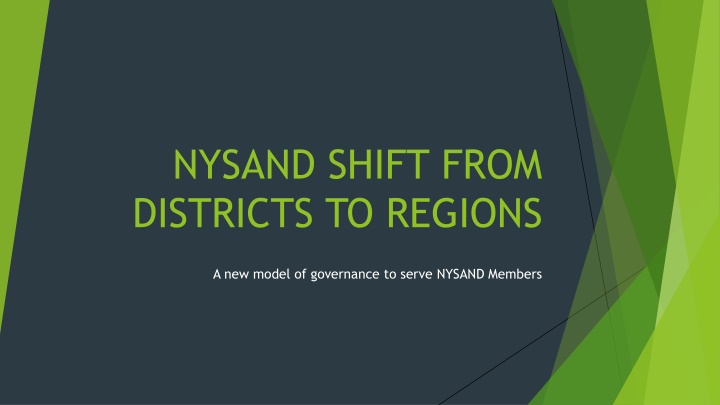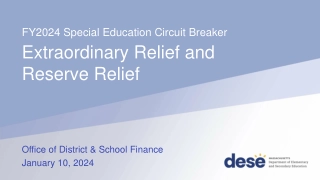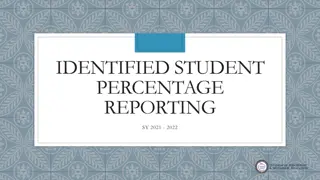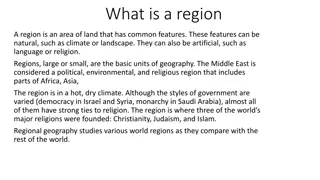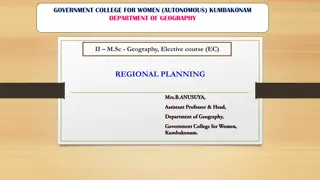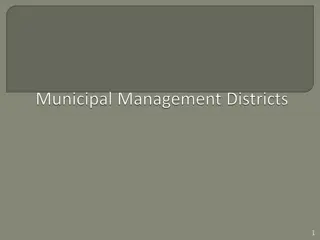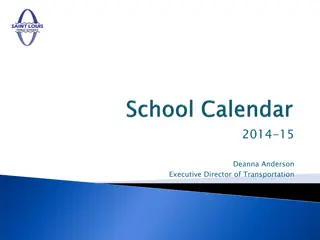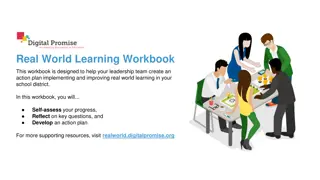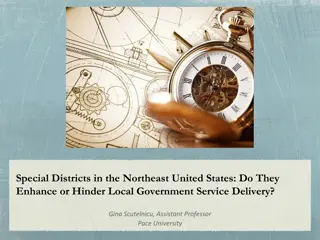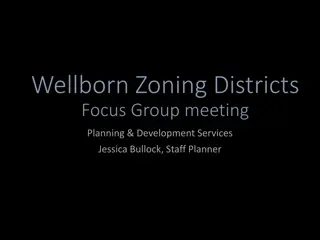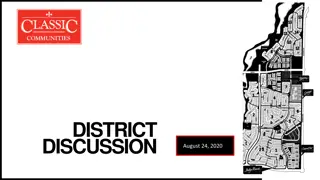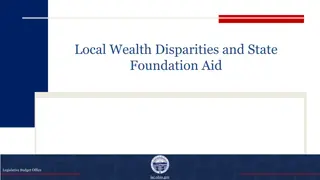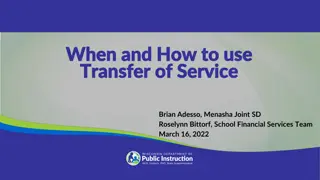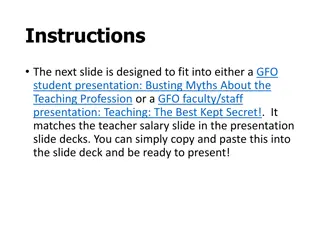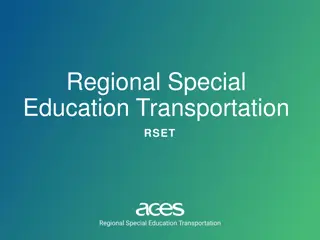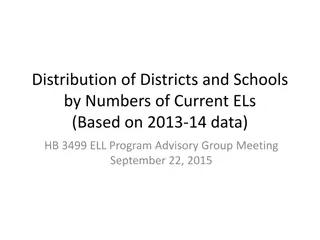NYSAND SHIFT FROM DISTRICTS TO REGIONS
In the shift from districts to regions, NYSAND is introducing a new governance model to better serve its members. Explore the transition, committee members, district self-assessment, delegate survey results, and member feedback on CEU, networking, and costs. The change aims to provide enhanced benefits and opportunities for NYSAND members.
Download Presentation

Please find below an Image/Link to download the presentation.
The content on the website is provided AS IS for your information and personal use only. It may not be sold, licensed, or shared on other websites without obtaining consent from the author.If you encounter any issues during the download, it is possible that the publisher has removed the file from their server.
You are allowed to download the files provided on this website for personal or commercial use, subject to the condition that they are used lawfully. All files are the property of their respective owners.
The content on the website is provided AS IS for your information and personal use only. It may not be sold, licensed, or shared on other websites without obtaining consent from the author.
E N D
Presentation Transcript
NYSAND SHIFT FROM DISTRICTS TO REGIONS A new model of governance to serve NYSAND Members
MICHELLE BARBER NYSAND President NYSAND District to Region Committee Member
District to Region Committee Members Chair: Virginia Vorhis, NYSAND Past Parliamentarian Committee Members: Michelle Barber, NYSAND President Kathy Border, NYSAND ByLaws/Handbook Chair Katie Brown, NYSAND Delegate Reyna Franco, NYSAND Secretary/Treasurer Angela Goscilo, NYSAND Chair of Delegates Sue Paredez, NYSAND Past ByLaws/Handbook Chair Julie Raway, NYSAND Past President Mary Beth O'Meara, NYSAND Parliamentarian NYSAND District Presidents & NYSAND District Presidents-Elect Victoria Palasieski, NYSAND Executive Director
What is happening on the district level? District Self Assessment Poll
SELF ASSESSMENT POLL Over the past few years, our district membership has: Increased Stayed the same Decreased During annual elections, our district has been able to fill all ballot slots: Yes No Unsure
SELF ASSESSMENT POLL (continued) Membership meetings are: Well attended Poorly attended Unsure Our financials are healthy: Yes No Unsure I am most proud of our district s (share a recent event, accomplishment, award, recognition or other!)
KATIE BROWN NYSAND Delegate WNYDA President NYSAND District to Region Committee Member
RESULTS OF DELEGATE MEMBER SURVEY September 2022
In a recent HOD Survey, NYSAND Members told us they are looking for more CEU, networking & reduced costs from an AND Membership NYSAND s conversion to regions will allow for all these benefits and more!
WHAT IS THE DIFFERENCE BETWEEN DISTRICTS AND REGIONS?
Each NYSAND District is a separate legal identity Each district has its own Articles of Incorporation and Bylaws
District vs. Regions Comparison DISTRICTS REGIONS Elected BOD Committees Develops Bylaws, P&Ps, Position Descriptions, Strategic Plan Develops Programs/CEUs and can charge for them Does own social media Financial Budget, Dues, Bank Accounts, Tax Returns, Contracts Provides local scholarships Requires membership to participate in district activities Recruits and maintains membership lists; collects dues Appointed Regional Board Coordinator Committees NYSAND develops Bylaws, P&Ps, Position Descriptions, Strategic Plan NYSAND coordinate CEUs with Regions and shares across the state NYSAND coordinates social media with regions NYSAND maintains budget (no dues), handles contracts, funds, financial matters NYSAND manages scholarship funds and district sets criteria AND/NYSAND Members become automatic Region members Regions can be adjusted as needed
REGIONS Regions are committees of the NYSAND Coordinating Cabinet. They are not independent not-for-profit organizations as are districts. Four regions have been created All NYSAND members belong to a region This year will be an organizational year starting Fall 2022 Establish Regional Board Committees Identify leaders Identify geographic hubs Begin program planning Individual district dietetic associations will decide whether or not to dissolve, shifting organizational responsibilities to NYSAND and regions
GINNY VORHIS Chair District to Region Committee
REGIONAL BOARD COMMITTEES Regional Board Committee Regional Coordinator appointed by the President of NYSAND Key Committees linked to NYSAND (i.e. Public Policy, Programing, Diversity & Inclusion, Nominating) Region Specific Positions Fewer volunteers needed as many functions will be taken over by NYSAND Role of the Regional Board Committee Creation of Region-specific policies and best practices Member event planning Member communication New project proposals Funding requests
NYSAND RESPONSIBLITIES Financial Provide regional funding (rebate from Academy dues and regional accounts) No dues Members of the Academy are automatically members of NYSAND and regions Provide accounting with separate budget lines Pay bills, negotiate contracts Centralize all communications
NYSAND Responsibilities (continued) Programing Coordinate CEU and event program planning with regions Share programming between regions as well as region specific events Fund programming though general funds, sponsorship, or a small fee for the event/offering Negotiate contracts Provide programing to rural areas CEU request/approval process
HOW TO CHOOSE DISTRICT ASSESSMENT
HOW TO CHOOSE You may consider dissolving your district when one or more of the following makes it difficult to function as an effective organization.
WHEN TO CONSIDER TO DISSOLVE District does not have a full Board District leaders are having to cover multiple positions and/or are the same leaders serving the district for many terms District is unable to identify qualified candidates for offices District membership declining District does not host activities, events or provide member benefits District lacks funding for programing
WHAT HAPPENS TO DISTRICT BANK ACCOUNTS AND ASSETS? District Assets will be turned over to NYSAND per dissolution requirements of your 501(c)(3) or (c)(6) organization Regions will be funded using the money from its founding districts and from Academy dues rebate to NYSAND The monetary assets from former districts will be administered by NYSAND for the use by its new region Regions will request funding through the annual budget process
IMPACT OF CHANGE
HOW ARE MEMBERS IMPACTED? No district dues Automatic members of a region (AND member = NYSAND member = Region member) More CEU opportunities across the region and state - open to all members - more variety Events retained at the local level: In-person CEU, networking, and social events Sharing of social media across the region and state = more attendance at events
Regions are no longer islands with no outside support! Financial Region has budget at NYSAND level Region does not have to perform routine accounting or annual tax return filings Region can charge and/or fundraise for CEU's, scholarships Resources can be shared across the region Organizational Fewer volunteers needed for regional positions and committees, larger pool of volunteers, well defined regional position responsibilities Shorter commitments No bylaws, policies and procedures, paperwork to maintain or update. Done at NYSAND level
HOW IS NYSAND IMPACTED? Increased responsibility and workload at the leadership level Complete ownership of banking and financial tracking for all NYSAND regions Recruitment for regional volunteers added to the Nominating Committee duties Strategic Plan modifications Development of statewide events Centralize and expand communication plans Administer funds for former district scholarships or lectures While regions may choose to retain ownership of the selection process, NYSAND will assume responsibility of holding and managing the funds
DISSOLUTION PROCESS
DISSOLVING YOUR DISTRICT Dissolving your district requires many steps and filing official paperwork NYSAND leaders will be available to help guide you in the process NYSAND is retaining legal counsel to assure the process is done efficiently and correctly Standardized forms and process will be developed Districts can either pursue dissolution on their own or use the NYSAND lawyer on a fee for service basis
STEP 1: NYS CHARITIES BUREAU All 501 (c) (3) Organizations need to be registered with the NYS CHARITIES BUREAU whether you dissolve your district or not Online application and fee File CHAR500 for current year and past 3 years If already registered, know your registration number and be current with CHAR500 filings.
PREPARE TO DISSOLVE STEP 2: BOD agrees to proceed with dissolution Update Bylaws if needed to simplify/clarify voting Identify assets Identify liabilities Develop a plan stating how the organization will proceed with settling assets and liabilities Member education STEP 3: BOD or MEMBER VOTE (according to your bylaws)
TIMELINE Each individual district will have its own timeline. The District has 270 days to execute the Plan after receiving Attorney General or court approval Execute your Plan Pay labilities Distribute assets Wind up its business in accordance with the Plan File tax returns
The perspective of a District President
GOING FORWARD It is up to your Board and your Members
NOVEMBER 1, 2022 Districts will inform NYSAND President of the expected direction of their district Dissolve Stay a district Or not ready yet to decide
NEXT STEPS (timeline flexible based on individual district needs) Register with the NYS Charities Bureau Educate members on the transition to a regional structure (with NYSAND) Critically assess if their district is meeting member needs has enough volunteer leaders to meet its goals Call for a member vote for dissolution of the district
NEXT STEPS (continued) When/if district members approve, the District Dietetic Association Board needs to: Determine how this will impact spring elections for 23-24 District leaders will need to work closely with NYSAND to work through Dissolution of their district not-for-profit organization Transfer of assets to NYSAND Identify leadership willing to serve in regional positions
MEMBERS NOT READY FOR CHANGE? That is OKAY! District Dietetic Associations remain in NYSAND s structure, and you may continue to maintain your independent association status and affiliation with NYSAND and its regions. Your decision to join a region can happen in the future, but you should make an objective assessment how your district is doing now and where do you see your district in the future.
REGION PLANNING BRAINSTORMING SESSION
GROUP ACTIVITY BRAINSTORMING Benefits of a regional system Potential pitfalls District member concerns Perceived or voiced barriers to change to regions Other burning questions or ideas?
TABLE ACTIVITY FOR REGIONS BRAINSTORMING What is unique to your district that you do not want to lose? Who are your leaders? What committees might your region need? Identify contact hubs within the district. How would this work? CEU programing ideas? Social events ideas?
